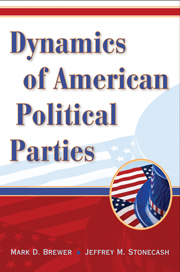Book contents
- Frontmatter
- Contents
- Figures and Tables
- Preface
- 1 DEMOCRACY, REPRESENTATION, AND PARTIES
- 2 OVERVIEW: SOCIAL CHANGE AND SHIFTING PARTY BASES
- 3 TAKING SHAPE: PARTY COALITIONS IN THE POST-BELLUM NINETEENTH CENTURY
- 4 REPUBLICAN ASCENDANCY AND DEMOCRATIC EFFORTS TO RESPOND, 1896–1928
- 5 TABLES TURN: THE NEW DEAL ERA AND DEMOCRATIC DOMINANCE, 1932–1948
- 6 THE DEMOCRATIC DRIVE TO THE GREAT SOCIETY
- 7 REPUBLICANS: REASSERTING CONSERVATIVE PRINCIPLES AND SEEKING A MAJORITY
- 8 THE STRUGGLE OF DEMOCRATS TO INTERPRET CHANGE AND RESPOND
- 9 GEORGE BUSH AND FURTHER POLARIZATION
- 10 THE 2008 ELECTION AND ITS INTERPRETATION
- 11 PARTIES AND THE PURSUIT OF MAJORITIES
- Bibliography
- Index
- References
1 - DEMOCRACY, REPRESENTATION, AND PARTIES
Published online by Cambridge University Press: 05 June 2012
- Frontmatter
- Contents
- Figures and Tables
- Preface
- 1 DEMOCRACY, REPRESENTATION, AND PARTIES
- 2 OVERVIEW: SOCIAL CHANGE AND SHIFTING PARTY BASES
- 3 TAKING SHAPE: PARTY COALITIONS IN THE POST-BELLUM NINETEENTH CENTURY
- 4 REPUBLICAN ASCENDANCY AND DEMOCRATIC EFFORTS TO RESPOND, 1896–1928
- 5 TABLES TURN: THE NEW DEAL ERA AND DEMOCRATIC DOMINANCE, 1932–1948
- 6 THE DEMOCRATIC DRIVE TO THE GREAT SOCIETY
- 7 REPUBLICANS: REASSERTING CONSERVATIVE PRINCIPLES AND SEEKING A MAJORITY
- 8 THE STRUGGLE OF DEMOCRATS TO INTERPRET CHANGE AND RESPOND
- 9 GEORGE BUSH AND FURTHER POLARIZATION
- 10 THE 2008 ELECTION AND ITS INTERPRETATION
- 11 PARTIES AND THE PURSUIT OF MAJORITIES
- Bibliography
- Index
- References
Summary
The premise and hope of democracy is that voters matter. In a representative democracy, we want politicians to be sensitive to the concerns of voters and accountable to voters when they do or do not take action. The process of gaining representation for voters, with all their differing needs and ideas, is not simple. Voters have a multitude of differing and conflicting opinions, interests, and needs. Some want government to intervene and help solve social problems. Others strongly oppose government intrusion because they think government will do harm. There are virtually endless numbers of such conflicts that exist within any free society.
Somehow those differing needs and concerns have to achieve representation. There has to be some organized and sustained effort to raise issues, make arguments for or against public policies, and keep attention on those issues. Political parties are crucial actors in this process. They seek to bring together different electoral groups to create a majority that can win elections and control government. Sometimes a social or demographic group may initiate a focus on an issue, and party politicians see the potential to win the votes of that group. Other times, party politicians see a problem emerging and formulate a set of policies to respond with the hope of winning the votes of those affected. However the interaction begins, the goal of a party is to represent concerns, build a coalition, win votes and create a majority. That dynamic creates representation for interests in society.
- Type
- Chapter
- Information
- Dynamics of American Political Parties , pp. 1 - 15Publisher: Cambridge University PressPrint publication year: 2009



